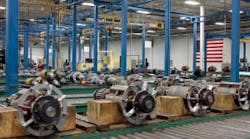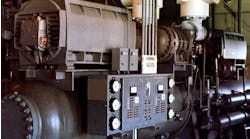For electric motor users, it’s pencil-sharpening time. With new federal motor efficiency standards looming, calculations on repairing or replacing aging or damaged motors — which are rarely clear cut to begin with — are about to get more muddled.
The biggest new variables are both the higher up-front costs and potential expanded energy savings associated with motors manufactured to new standards codified in the Energy Independence and Security Act of 2007 (EISA) slated to take effect Dec. 19, 2010. A broad range of motors built after that date will have to conform to nominal full-load efficiencies that define premium-efficient motors, commonly marketed as “NEMA Premium.” Many others will have to take a smaller, yet still meaningful, step up in efficiency as well.
The new calculus
Crafted to nudge many motor users toward products that use less energy by addressing the supply side of the equation, EISA nonetheless crystallizes their timeless repair vs. replace dilemma. While that’s especially true for users who may be forced into choosing between now and the December effective date — while less expensive motors are still available — it will also likely be the case well into next year and beyond.
With premium-efficient motors carrying a price tag of up to 30% more than either EPAct or standard efficiency motors, some users could have more incentive to consider the advantages of maintaining and repairing old, less efficient motors as the need arises. But at the same time, the new higher efficiency motors do offer a quicker payback period, helping blunt the higher up-front cost. Combine that with strong prospects for steadily increasing electricity costs and the certainty of dwindling supplies of older motors, and the average user may find the scales tipping in favor of replacement.
That’s a case certain to be made forcefully by motor manufacturers, and to a lesser degree, perhaps, by distributors that specialize in both new motor sales and repair/rewind services. With many standard efficiency motors’ history, once the pipeline is empty, manufacturers and distributors will simply transition replacement customers to new premium efficiency products. Repairers, though, may be more conflicted in working with clients, weighing the loss of steady rewind/maintenance/refurbishing revenue against arguably sound counsel to install premium-efficient motors to get on a quicker path to controlling long-term energy expenditures (see SIDEBAR: The Excess Inventory/Obsolete Equipment Equation).
Ultimately, though, a user’s decision to repair or replace motors will turn on many of the usual “pay me now, or pay me later,” considerations, says George Flolo, general manager of The Flolo Corp., a motor sales and service company in Bensenville, Ill. For some users whose business may be struggling in a sluggish economy and are looking for ways to trim costs in the short term, repairing existing motors might emerge as the expedient, if not enlightened, choice.
“With these new motors up to 30% more costly and the economic situation being what it is, that could change the calculations for some companies,” says Flolo, who chairs the Marketing and Industry Awareness Committee of the Electrical Apparatus Service Association. “Some may conclude that repairing the motor with best practices so it retains its efficiency and works as soundly as before translates to a meaningful 20% savings over replacement.”
On the other hand, users more focused on the short term may opt to snap up cheaper, though less efficient, motors while supplies last. While most manufacturers are moving swiftly to shift production of EISA-covered motors to premium efficiency, those ultimately marked for replacement can legally roll off assembly lines through late autumn.
Indeed, some distributors say they’re fielding inquiries from customers interested in investing in less expensive motors while they still can. Cheryl Taylor, director of sales and marketing for Electric Motor & Contracting Co., Chesapeake, Va., says in anticipation of a few customers making that call the company has been arranging to lay in quantities with a cheaper price tag.
“There are some customers who are telling us they’ll worry about efficiency when they can afford to worry about it — and until then they want the cheaper motors,” she says. “We’ve talked with suppliers and some, like Toshiba, are telling us it will be first come, first served on existing supplies, which they say could last through the middle of next year.”
Pipeline fills
Motor companies in general, though, appear to be moving deliberately to transition to the new EISA era. Anticipating robust demand from users saddled with large quantities of costly, aging motors and the need to display a forward-leaning stance, some say manufacturers are ramping up production of premium-efficient motors. History shows, they say, that demand for phased-out motors that are out of vogue falls off quickly.
Rob Boteler, director of marketing for Emerson Motor Co., St. Louis, recalls that leading up to stricter motor efficiency standards courtesy of the Energy Policy Acts of 1992 and 1995 (EPAct ’92 and ’95), some manufacturers misjudged market demand.
“We thought some OEMs, for instance, would want to buy less efficient, lower cost motors while they could, but the opposite happened,” he says. “They wanted the higher performance motors and moved quickly to adopt them. Manufacturers don’t want their customers questioning whether they have NEMA Premium motors, and they certainly don’t want to say, ‘no, we don’t have them.’”
In fact, says John Malinowski, senior product manager — AC Motors, for Baldor Electric Company, Fort Smith, Ark., EISA will only serve to hasten the move to premium efficiency motors. While some customers may well be shocked when they wake up to the new efficiency standards in December, more have been busy adopting higher efficiency products.
“People want to buy high-efficiency motors,” he says. “Over the last five years, NEMA Premium motors have been our fastest growing segment of motor sales. They’ve shown double-digit growth during a time when industry motor sales have been mostly down. Companies have figured out this is an easy way to save energy.”
Incentives may emerge
If accelerated payback, long-term energy savings, and dwindling supplies of EPAct and standard efficiency motors alone aren’t enough to entice buyers on the fence, hefty rebates might do the trick. Federal “crush for credit” legislation that would provide up to $700 million of monetary incentives to accelerate the shift to premium-efficient motors has been marinating in Congress.
A renewed push took shape in June, with the introduction of Senate bill 3436. It would offers buyers rebates of $25 per horsepower for purchases of NEMA Premium motors. Plus, companies that permanently dispose of replaced, less efficient motors would get $5 per horsepower.
“That amount of money can be significant,” he says, noting that he thinks there’s still a lot of slack in premium efficiency motor demand that could be taken up using incentives. “I don’t think NEMA Premium sales have met initial sales goals. There are still a lot of even pre-EPAct motors being sold.”
The initial cost hurdle is likely to be the only major practical impediment to adoption, over time, of more efficient motors. Addressing production only, EISA does not effectively mandate any new motor design or manufacture technology, meaning no radical new designs are on tap. Market observers say premium-efficient motors that use time-tested technology and designs should merge seamlessly into most industrial, commercial, and OEM applications that may use less efficient motors. Though they generally use more copper and more and higher grades of steel, resulting in somewhat larger configurations, most are readily scalable and require few, if any, system retrofits.
“One of the things NEMA did when it drafted NEMA Premium guidelines was to push the envelope on maximizing efficiency without forcing motors to change dimensionally,” Boteler says. “Manufacturers have been able to maintain the same size and physical environment for motors.”
Challenges, opportunities
One major exception might relate to motors that conform to IEC (International Electroctechnical Commission) rather than NEMA standards. Such motors, built mostly outside the United States, are built on a smaller frame. Making such motors conform to EISA standards could prove physically challenging and cost prohibitive. That could result in some non-U.S. IEC motor manufacturers opting to step away from the U.S. market.
“They might encounter significant challenges in maintaining motor size while delivering performance,” says Boteler. “Users of IEC motors might be stuck repairing what they have if they can’t purchase new EISA-compliant motors.”
Though not covered by EISA, small electric motors might ultimately have to be sized differently. The U.S. Department of Energy recently published final rules aimed at bringing motors that meet the definition under stricter efficiency standards by 2015. NEMA Industry Director William Hoyt says the new rules pose some challenges.
“There may be some applications where small, single-phase motors would need an additional 20% stack length to achieve the mandated efficiency,” he says. “That would have some potential impact on OEM applications and designs.”
But long before those standards come into play, buyers and sellers of EISA-covered motors will likely have navigated most of the bumps associated with the market’s inevitable shift to more efficient motors. The pace of the long transition that begins in December, observers say, will likely hinge not only on the new math of standard ROI calculations, but also on the willingness of users to look at their motor usage in a larger context.
In isolation, they say, premium-efficient motors can make a fair dent in energy usage. But the real savings will stem from developing comprehensive motor management plans that entail motor usage optimization, system-wide efficiencies, optimizing repairs, and more in-depth monitoring of energy usage.
“From a motor engineering standpoint, there’s probably not that much more to achieve,” says Hoyt. “At this point, the industry is not looking at the next step forward in the efficiency tables, but more at the question of system efficiency, pairing advanced design motors with variable-speed drives, for instance, and gearing entire systems to achieve higher efficiencies of 40% and 50% — not just the 10% that may come from a premium motor alone.”
Zind is a freelance writer based in Lee’s Summit, Mo. He can be reached at [email protected].
SIDEBAR: Dissecting EISA’s Impact
Some things, as the saying goes, need an “act of Congress” to get done. Widespread adoption of more efficient electric motors? Perhaps. Regardless, federal legislation passed three years ago seeks to hasten the shift by mandating that manufacturers selling into the U.S. market build many new motors to higher efficiency standards come December.
The Energy Independence and Security Act of 2007 (EISA) requires general-purpose “Subtype I” motors in the 1-hp to 200-hp category — and manufactured alone or as a component of another piece of equipment — be built to minimum nominal full-load efficiency standards as defined in NEMA MG-1 (2006) Table 12-12.
Those standards generally define the premium-efficient motor — ones that may carry the NEMA Premium designation. That category came into being with passage of the Energy Policy Act of 2005, which required motors procured for federal uses to meet those higher efficiency ratings.
EISA effectively expands those federal procurement guidelines to many motors used in commercial and industrial applications. It succeeds efficiency standards that were mandated for such motors in the Energy Policy Act of 1992 (EPAct ’92). The new EISA standards are several percentage points higher than efficiency ratings that define those so-called EPAct motors, and which are spelled out in NEMA MG-1 (2006) Table 12-11.
EISA also raises the efficiency bar for various other types of motors. Some that had been exempted from EPAct ’92 standards, which were one to four percentage points higher than efficiency ratings for standard-efficiency motors, will now have to meet EPAct ’92 efficiency guidelines. Such motors, called Subtype II, incorporate Subtype 1 design elements but have non-standard configurations.
EISA also brings NEMA Design B motors sized between 200 hp and 500 hp under the EPAct ’92 efficiency prescriptions, as well as fire-pump motors.
SIDEBAR: Motor Mandate Specifics
Motors covered by the new energy efficiency requirements (i.e., manufactured after Dec. 19, 2010) for sale in the United States include:
-
General-purpose motors (Subtype I) with a power rating of at least 1 hp but not greater than 200 hp (these are motors that were affected by EPAct in 1997), shall have a nominal full-load efficiency that is not less than as defined in NEMA MG–1 (2009) Table 12–12. Subtype I motors include:
-
230V or 460V, 60 Hz, NEMA Design A or B and IEC
Design N, 2-, 4-, or 6-pole induction motors -
IEC metric frame motors, 90 frame and up
(excluding 100 frame)
-
230V or 460V, 60 Hz, NEMA Design A or B and IEC
-
General-purpose motors (Subtype II) with a power rating of at least 1 hp but no more than 200 hp shall have a nominal full-load efficiency that is not less than as defined in MG–1 (2009) Table 12–11. Subtype II motors include:
- U-Frame motor
- Design C motor
- Close-coupled pump motor
- Footless motor
-
Vertical solid-shaft normal thrust motor (tested in a
horizontal configuration) - 8-pole motor (900 rpm)
-
3-phase motor with voltage of no more than 600V
(other than 230V or 460V) - Fire pump motors
- NEMA Design B or IEC Design N, general purpose electric motor, with a power rating at least 200 hp but no more than 500 hp shall have a nominal full-load efficiency that is not less than as defined in MG-1 (2009) Table 12–11.
- Motors mounted to equipment imported into the United States.
Note: Natural Resources Canada (NRCan) regulations take effect on Jan. 1, 2011, and differ slightly from U.S. laws. Canada adds footless motors and all voltages less than 600V to the 1-hp to 200-hp motor category requiring premium efficiency rating per NEMA MG 1 (2009), Table 12-12.
Motors not covered by the new energy efficiency requirements include:
- Single-phase motors
- DC motors
- 48 or 56 frame motors
- Fractional hp motors
- Totally enclosed non-ventilated and totally enclosed air-over motors
- Design D motors with high slip
- Inverter duty motors with windings optimized for adjustable speed drive
- Customized OEM mounted motors
- Intermittent duty motors
- Integral motors with gearing or brake, where motor can’t be used separately
- Submersible motors
SIDEBAR: The Excess Inventory/Obsolete Equipment Equation
With new Energy Independence and Security Act of 2007 (EISA) efficiency standards, a new era of electric motor manufacturing will dawn in December. However, the curtain won’t necessarily fall immediately on the use of older, less efficient motors. The fact that motor users will still be able to use and acquire older motors is good news for companies that refurbish, repair, and resell used and surplus equipment. Yet such companies are likely to find that both supply and demand realities essential to their business models will indeed change.
Jay Romanoff, president of Romanoff Industries, Inc., Toledo, Ohio, says that over time, EISA will surely have the effect of ramping up production of costlier, higher efficiency motors and prompting many users to make the switch to brand new products that meet the new standards. But he mostly worries about the impact that a proposed federal rebate program on such purchases will have on distorting the market for used motors and, in turn, the viability of his used/remanufactured/reconditioned electric motor reselling business.
Senate legislation that would not only give purchasers of new higher efficiency motors a rebate, but also pay to have motors that they replace scrapped, could reduce the stock of motors that still have value.
“This idea of putting a bounty on older, less efficient motors is a direct threat to my business,” Romanoff says. “If the scrap value of older motors rises beyond the price that they can be sold for on the used market, fewer will be available for the reselling market.”
That’s a market that has stayed strong, even as previous rounds of efficiency mandates have taken root, Romanoff says. For many consumers, used motors, even if they’re comparatively inefficient, still make economic sense because they’re cheaper and easily swappable. If more used motors are taken out of service permanently, buyers will see less supply and higher prices of used equipment, he argues.
EISA, especially if it’s buttressed by purchase rebates and a “crush for credit” provision, will probably mean his business will be steadily more geared to sales of new motors in the future, Romanoff says. Nevertheless, another used motor company owner, Dave Rosenfield, sees the demand for older motors of varying efficiencies possibly staying strong, particularly in applications not covered by EISA.
“Many of the inquiries we get are for replacement applications that can’t be satisfied by what manufacturers are making today, products that are on obsolete frames, for instance,” says Rosenfield, the president of Romac Supply Co., Inc., Los Angeles. “We work to carefully match products to their individual needs, and, if higher efficiency product is available, we’ll get it.”
But Rosenfield does see a steady move to higher efficiency motors. As that definition changes, affecting licensed/inspected applications, the market for some aging used motors may well wither.
While it may be a positive development to ease aging, energy-hogging motors out, Romanoff questions the net effect of EISA, particularly the rebate scheme. By artificially inflating the market for new motors, policymakers could even be undercutting EISA’s intent by setting the stage for more energy usage and global warming. There’s no assurance new motors will actually replace older motors or that older ones will, in fact, be taken out of service.
“Many of these scrapped motors may well find their way back to countries where there are no motor standards,” he says. “And we also may be overlooking the fact that building new motors may require more energy than repairing and recycling older motors.”



